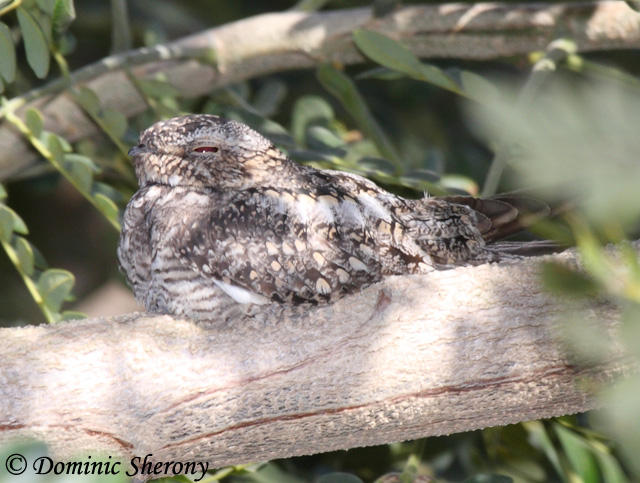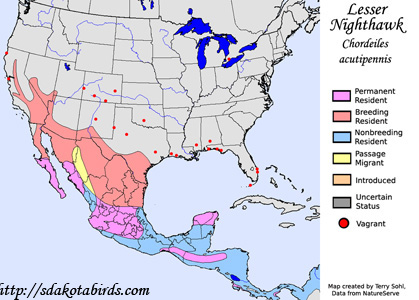Lesser Nighthawk
Chordeiles acutipennis
| Length: 9 inches | Wingspan: 22 inches | Seasonality: Non-resident in South Dakota |
| ID Keys: Pale bar near wingtips visible in flight, mottled sandy gray plumage overall, buffy areas on underparts | ||
 The
Lesser Nighthawk is very similar to the
Common Nighthawk, a bird found over much of the U.S. and Canada during
the summer months. The Lesser Nighthawk, however, is strictly a bird
of warm areas of the southwestern U.S. and Mexico, preferring dry
environments such as deserts and dry grasslands. The two species do
overlap in range in some parts of the Southwest, but there, Lesser
Nighthawks are typically found in drier, lower elevation areas than their
larger cousins.
The
Lesser Nighthawk is very similar to the
Common Nighthawk, a bird found over much of the U.S. and Canada during
the summer months. The Lesser Nighthawk, however, is strictly a bird
of warm areas of the southwestern U.S. and Mexico, preferring dry
environments such as deserts and dry grasslands. The two species do
overlap in range in some parts of the Southwest, but there, Lesser
Nighthawks are typically found in drier, lower elevation areas than their
larger cousins.
Habitat: Found in dry habitats of the desert Southwest and in Mexico, including desert areas, dry grasslands, and arid scrublands.
Diet: Feeds on flying insects.
Behavior: Will feed at all times during the day, but most often feeds near sunset. They feed while in flight, opening their large mouth very widely and gathering insects. Sometimes they will also feed on insects on the ground.
Nesting: Nesting occurs on the ground, with no formal nest built. The female lays 2 eggs directly on the ground, and she alone incubates them. When the eggs hatch, both parents help to feed the young by regurgitating insects. The young leave the nest after about 3 weeks.
Song: The song of a Lesser Nighthawk is a long, low pitched trilling whistle, all given at one pitch.
Migration: Birds in some parts of Mexico are likely permanent residents. Those that summer in the United States are nearly all migratory, with birds moving as far south as South America for the winter. There are a few that may overwinter in the far southwestern United States.
Interactive eBird Map: Click here to access an interactive eBird map of Lesser Nighthawk sightings
Similar Species: Common Nighthawk, Antillean Nighthawk
Conservation Status: Populations of Lesser Nighthawks are widespread and common in many areas, and they may be increasing. The IUCN lists the Lesser Nighthawk as a species of "Least Concern".
Further Information: 1) USGS Patuxent Bird Identification Infocenter - Lesser Nighthawk
2) Audubon Guide - Lesser Nighthawk
3) WhatBird - Lesser Nighthawk
Photo Information: Photo taken by Dominic Sherony - February 19th, 2009 - Nayarit, Mexico - Photo licensed under Creative Commons Attribution ShareAlike 2.0 Generic License.
| Click below for a higher-resolution map |
 |
| South Dakota Status: Non-resident in South Dakota |
Additional Lesser Nighthawk Photos (coming soon!!)
